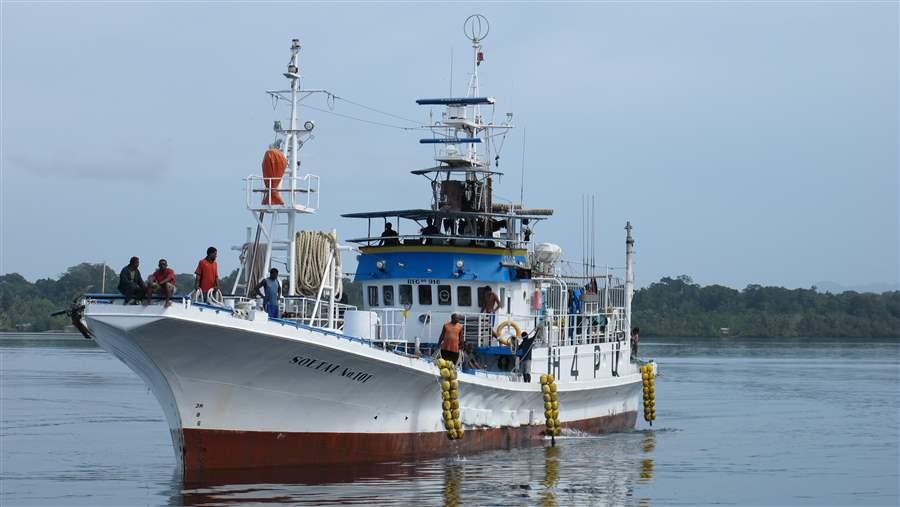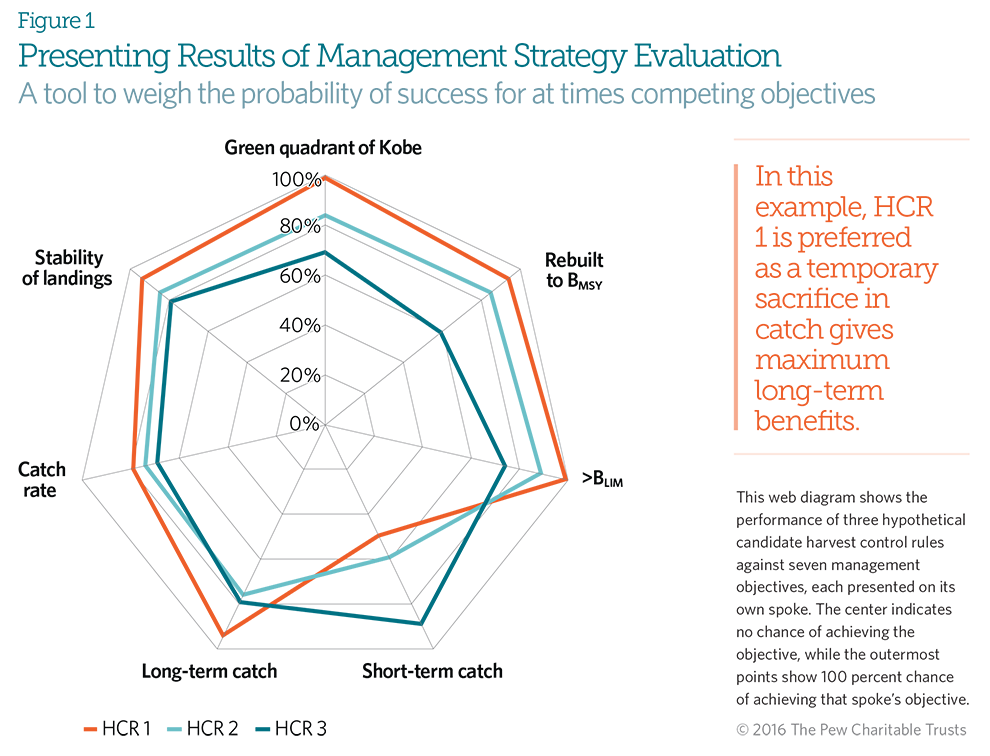Harvest Strategies: Management Objectives
Charting the future of tuna management
 The Pew Charitable Trusts
The Pew Charitable TrustsTuna regional fisheries management organizations are generally guided by an overarching mandate to maintain populations at or above the level that can produce maximum sustainable yield.
In recent years, managers of tuna fisheries around the world have begun to shift to using harvest strategies, or management procedures, because they offer a more predictable and stable approach than the traditional use of stock assessments followed by often contentious quota negotiations. The effectiveness of harvest strategies depends, in large part, on managers first agreeing to a set of management objectives for the fishery and the stock, and then using a process called management strategy evaluation (MSE) to select a harvest control rule that is most likely to achieve these goals.
Agreement on management objectives can be one of the most challenging steps in the process, but defining the objectives at the start helps ensure that they drive the selection of a final harvest control rule. Although legislative or convention objectives for fisheries are often expressed in general terms, the process of developing harvest strategies requires that they be spelled out in language that is meaningful, specific, and acceptable to managers, stakeholders, and scientists. An iterative process of suggestions and testing can help to build this mutual understanding about operational objectives.
Tuna regional fisheries management organizations (RFMOs) are generally guided by an overarching mandate to maintain populations (biomass, or B) at or above the level that can produce maximum sustainable yield (BMSY). The harvest strategies approach allows managers to identify additional management objectives, such as fishery stability, which can be used to help set the target state for the fishery and stock, as well as the conditions to avoid, such as recruitment overfishing—when adult fish are depleted to the point where the stock cannot replenish itself.
Specific objectives help measure success
Managers at the Indian Ocean Tuna Commission have taken the lead in recent years, outlining five basic categories of management objectives to be considered in harvest strategy development.1 These categories are now being considered in the Atlantic and Pacific oceans as well:
- Status: To maximize the probability of maintaining the stock in the green zone of a fishery’s Kobe plot (i.e., not overfished, no overfishing).
- Safety: To minimize the probability that the stock will fall below the biomass limit reference point or BLIM
- Yield: To maximize catch (or effort) across regions and/or fishing gears.
- Abundance: To maximize catch rates to enhance fishery profitability.
- Stability: To maximize stability in catches to reduce commercial uncertainty by minimizing variability in catch from year to year.
Potential objectives, however, are not limited to these categories and can reflect other goals for the fishery, such as a preference for the use of specific gear types that result in lower bycatch rates. In addition, some harvest strategies can include multiple objectives for the “status” category, the broadest of the five because of the range of potential goals, including biomass targets, fishing mortality rate targets, and rebuilding programs.
Whenever possible, objectives should be specific and measurable, with associated timelines and acceptable levels of risk, so the management system can be evaluated and modified when necessary. This is particularly true for the status- and safety-related objective categories (e.g., a 5 percent risk of breaching the limit reference point or a 75 percent chance of rebuilding to BMSY within 10 years). Terms that are undefined, such as “high probability” or “in as short a time as possible,” are subject to interpretation and lead to a lack of clarity that complicates management negotiations.
Some management objectives will conflict with others—for example, maximizing catch and minimizing the chance of breaching the biomass limit. That means managers may have to weigh objectives differently and consider trade-offs when selecting the final harvest control rule. While fisheries provide food, employment, and economic benefits for many, these benefits are attainable only if biological productivity and health are maintained. Consequently, management objectives must be weighted to ensure a very high probability of achieving the status and safety objectives for a fishery. Efforts to optimize other objectives should not compromise these goals. Web diagrams (also known as radial graphs, multicriteria radar charts, or spider plots) can be used to display the trade-offs frequently considered in the MSE process. (See Figure 1.)

Acceptable Levels of Risk
One of the most critical steps in the harvest strategy development process is choosing the levels of risk that will guide future fishery decisions. When evaluating and selecting harvest control rules, managers must decide the risk level that will most appropriately deliver precautionary management. Often, these levels are codified in the fishery’s management objectives.
Risk is defined in terms of the likelihood of a negative outcome, such as stock collapse or breaching the limit reference point. Conversely, it can establish the probability of success, such as the chance of achieving a target reference point or not breaching the limit reference point.
Unfortunately, fisheries management in the past has been prone to high levels of risk. For example, stock rebuilding programs were typically designed to have just a 50 percent chance of success, though the odds have been better for some, at 60 percent. In other cases, the language was vague, with management measures required to have a “very high” probability of success. With no defined quantitative level, the exact risk level was often subject to interpretation and political negotiation.
How acceptable risks are chosen is critical. Risk-prone management with low to medium probabilities of successful outcomes can prove dangerous to the future health of a stock and fishery. On the other hand, risk-averse management with a high probability of successful outcomes helps ensure an abundant future for the stock and the fishermen it supports.
Managers can draw on a growing body of knowledge and guidelines when setting acceptable levels of risk. The United Nations Fish Stocks Agreement broadly calls for the risk of breaching limit reference points to be “very low” and for target reference points to be met “on average.” Typically, these qualitative descriptions are interpreted as 5 to 10 percent and 50 to 75 percent, respectively.
For example, Australia and the Commission for the Conservation of Antarctic Marine Living Resources each have harvest strategy policies that require a less than 10 percent chance of violating the limit reference point. In Canada, the Fishery Decision-Making Framework Incorporating the Precautionary Approach defines quantitative levels for a series of qualitative risk designations, including defining “very low” as less than 5 percent.2 Typically, managers should set low levels of risk tolerance in cases of greater uncertainty.
Conclusion
Setting management objectives gives a clear direction for the fishery, which benefits fishermen through increased transparency and predictability. When quantified, management objectives measure how well the harvest strategy performs, which helps scientists and managers evaluate the effectiveness of the program. If adopted early in the harvest strategy process, management objectives set the vision for the fishery and provide mechanisms for measuring the strategy’s success over the long term.
Endnotes
1. Indian Ocean Tuna Commission, “Report of the 2nd IOTC Management Procedure Dialogue” (April 2015), http://iotc.org/sites/default/files/documents/2015/07/IOTC-2015-MPD02-RE_-_FINAL.pdf.
2. Fisheries and Oceans Canada, “A Fishery Decision-Making Framework Incorporating the Precautionary Approach,” last modified March 23, 2009, http://www.dfo-mpo.gc.ca/fm-gp/peches-fisheries/fish-ren-peche/sff-cpd/precaution-eng.htm.








